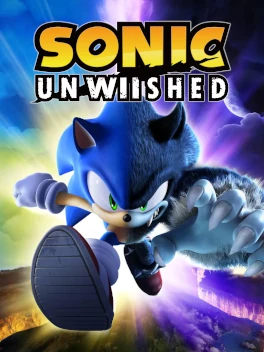Sonic Unleashed ★★★☆☆

It’s always interesting to see different takes on the same core idea. I knew when Unleashed Recompiled was released that I would be playing this alongside that fancy new PC port of the XBox 360 version. This Wii version takes the core concepts of the game and executes them in very different ways and it’s a lot better than I expected!
Being the budget version of the game a lot of fat is trimmed. Hub areas in each country are replaced with a more visual novel-style menu interface, using static renders of locations and characters from the PS360 version for visuals. This saves some time compared to running around and talking to people in the other version but is still tedious and fiddly and you do have to talk to people a lot more to progress. There is one part in particular after getting to Spagonia and Mazuri where you keeping having to go back and forth talking to different characters and watching cutscenes (FMVs that also use the in-engine cutscenes from the PS360 version as pre-rendered assets) for so long that I was begging the game to just let me play a level.
But when I actually got to play the levels they are quite fun! I actually prefer the werehog in this game to the PS360 version. There are motions controls if you would like, and it is fairly charming to do left and right hooks to attack or swing your arms rapidly to climb, but they are a bit much to play the whole game with, especially when there there is also fairly involved movement and platforming on top of it, but the game offers full support for the Gamecube or classic controller too. Even on the more standard control scheme the left and right punch are still bound to separate buttons. This is probably a holdover from the motion controls but I honestly enjoy it. It means you have to alternate left and right shoulder buttons to do combos making it just that little bit more engaging than just mashing attack repeatedly. Enemies also mercifully die much faster in this version.
I also quite like the werehog’s general movement. There is a real feel of weight and momentum in the way you skid while turning when running (even if having to double tap a direction to run is fiddly) and I also like you hold X to grab things rather than just tapping it. It gives you that little feeling that you’re gripping onto it yourself.
The night stages are also divided up into sets of three smaller acts rather than one big level. This puts them in more manageable chunks and means you lose less from a game over (which are a bit more likely in this version, more on the lives system later). Each act also takes place is a pretty distinct area. In Dragon Road (set in Chun-nan, based on China) the first area takes place in an area with lots of shrines and pagodas, similar to the PS360 version of the stage, but the two subsequent acts have you ascending a waterfall and then running across the Great Wall.
For the daytime stages the motion controls stop being a fun gimmick and are really just a hindrance, but the control scheme for more standard controls work just fine. The day stages are an interesting and very different take on the boost gameplay. How that should work was not set in stone yet and it feels like a real road not taken for how the series could have worked. Boost being discrete bursts of speed rather than a meter you drain continuously was strange to me at first but works pretty well. You really have to think much more about timing when to boost because you are committing to it and it can send you off a cliff that you can’t stop running towards. That along with the system where you are rewarded with boost for action chains and drifting feels like the game really rewards constant activity and hitting everything in the level just right. Rings upgrading your boost gauge with extra charges also gives more incentive not to just collect rings but hold on to them which later games don’t really do. It’s really rhythmic and intense in a different way to the boost formula I’m more familiar with. I am a bit tired of these games at the moment but I’ve definitely tempted to come back and practise the daytime levels more and get to grips with what a perfectly executed level feels like in this game.
I did think the game was a bit unforgiving with lives, only giving you three attempts at a level before a game over with no way to collect more, but what I had missed is that extra lives are actually a permanent upgrade in this game that you have to get elsewhere, but once you get an extra life you have that extra life for every subsequent level that you play. This is what the sun and moon medals are for in this game; they don’t gate progress like in the PS360 version. They also aren’t found through exploring, not directly at least. They are gotten through getting good performance in levels. For daytime levels this does just mean going as quickly as possible and beating certain par times. For the nighttime levels though there are three separate criteria for earning them for each level: You get one for beating the level under a certain time, one for getting enough “force” (experience points, basically) which can be found in high amounts throughout capsules hidden in little nooks and side areas—thus making those medals your reward for exploration—and one for getting enough rings, which just means being careful to hoover them up as you progress normally. This gives you some leeway in how to play levels if you still want to get some sun medals without worrying about getting them all.
What the sun and moon levels gate in this version is side areas in temples with extra puzzles. These puzzles require you to change back and forth between hedgehog and werehog and use their different movesets to peal back the layers of the puzzle in a way that you never do in the other versions of the game. And it is optional, though one might struggle in the last few levels without the extra lives. I certainly did before I realised that I had missed this entire system.
The final boss is also better in this version I think. Certainly the Punch-Out section is more fun than the equivalent part from the PS360 version. The Super Sonic part is a bit dull but certainly a lot less janky than those parts often are in this series.
Like its alternative version this is not without major flaws but I was surprised by how much more I want to go back to and fully get to grips with this version, this different angle on the series.
